Student Portraits
Our community of doctoral students is what makes MaP Doctoral School a special place. Catch a glimpse at our students' diverse research backgrounds, their commitment to MaP, and their aspirations.
2025
“From food science to the physics of fungi”
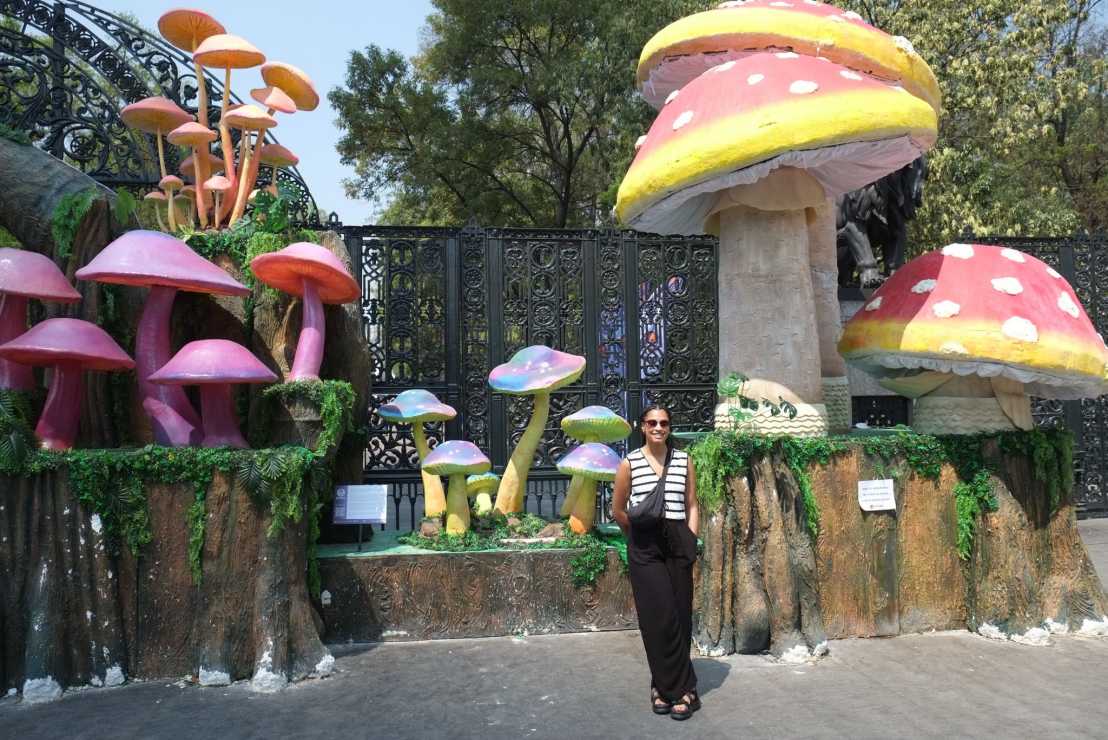
Ciatta Wobill has just completed her doctorate in Prof. Peter Fischer’s Food Process Engineering group at the Department of Health Sciences and Technology (D-HEST).
My research
I worked with mycelium, the root-like structure of fungi. The original aim was to develop a meat alternative using solid-state fermentation to mimic the fibrous texture of meat. That meant identifying a soft, edible material the fungus could grow into—something that would support and shape its development.
We experimented with different fungal species and substrates, but the focus soon shifted from food products to exploring how material properties affect fungal growth. What happens when the host material is softer or stiffer? How can we design it to guide the fungus? And how do we measure these changes? These questions led us into material physics and rheology.
To tackle them, I even worked with wood-based materials—food substrates proved too complex to isolate specific influencing factors. Mycelium reacts to everything, so the more controlled the host, the clearer the insights. Over time, my work became less about food and more about the mechanics of living materials. We tried so many things—many didn’t work, but each ‘failure’ helped shape the next step. In the end, my thesis brought together three papers (one published, one accepted, one under review), plus an additional chapter.
My MaP moment
At first, I felt a bit on my own. Working with fungi was new for our group, and everything about my project was unfamiliar. But I was drawn to how broad the topic became, bridging food science, material science, and microbiology. That interdisciplinary aspect led to valuable collaborations with the Department of Materials (D-MATL). Through MaP, I joined the ALIVE initiative’s CliMa group as a partner, which connected me with others at ETH working on mycelium and living materials. These exchanges—especially with Julie Laurent (Complex Materials), Robert Kindler and Sophie Koch (Wood Materials)—greatly enriched my research. They reminded me how important it is to get input from beyond your own lab bubble.
My future
Having completed a Bachelor's in food science, a Master's in food process engineering, and most recently a doctorate, I’ve spent close to ten years at ETH. Over time, my focus expanded beyond food to encompass material science, reflecting the interdisciplinary nature of my work. I’m now ready to take the next step and explore opportunities beyond academia—ideally in industrial research within the food sector, pharmaceuticals, or materials. I remain open and curious, and I’m excited to see where this next phase of discovery and growth will take me.
Looking ahead, I hope to lead my own interdisciplinary lab, where I can contribute to technologies that have a tangible impact on people’s lives. Whether in academia, industry, or entrepreneurship, my focus will remain on creating robotic and assistive systems that function effectively in the real world.
(This article was published on 23 May 2025 on LinkedIn)
“Beyond technological advancements, I want my research to have a tangible impact on people’s lives.”
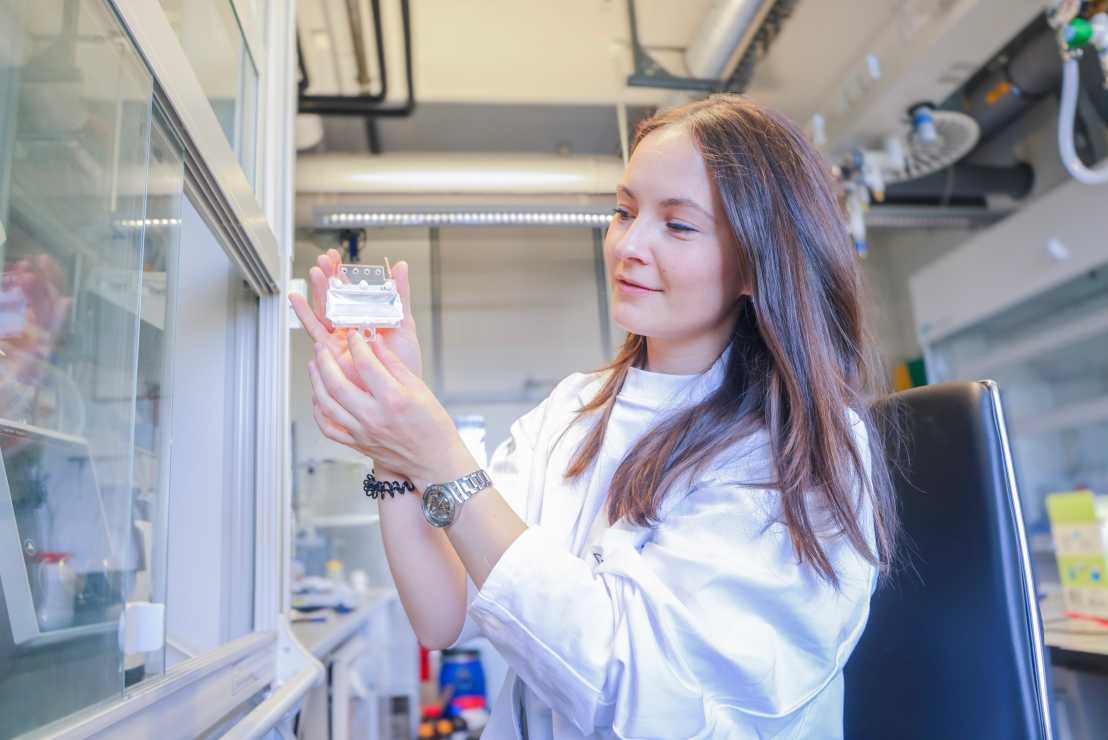
Daniela Macari is a fourth-year doctoral fellow of the Max Planck ETH Center for Learning Systems. She is co-advised by Prof. Stelian Coros in the Computational Robotics Lab at ETH Zurich’s Department of Computer Science and Prof. Christoph Keplinger at the Max Planck Institute for Intelligent Systems in Stuttgart.
My research
I specialise in the development of ultra-strong artificial muscles inspired by biological ones. These muscles, known as soft actuators, are made from polymers and insulating fluids and respond to electric fields by changing shape and generating force.
My work combines materials science, robotics, physics, and polymer chemistry, building on my background in mechanical engineering – specifically in high-performance, high-efficiency driving systems.
Traditional robots, made of rigid components, perform exceptionally well in highly controlled environments but struggle in dynamic, real-world situations. In contrast, nature has designed systems that seamlessly blend rigidity and softness, enabling adaptive and efficient movement. To bridge this gap, I work with composite ferroelectric polymers that exhibit excellent electromechanical properties. By fine-tuning their electrical and mechanical behaviour, I aim to create artificial muscles that are not only incredibly strong but also lightweight, soft, and adaptable to changing environments. This research has promising applications in robotics, prosthetic devices, and assistive technologies.
My MaP moment
Working in materials science in a computational robotics lab is both enriching and intellectually stimulating, but at times, it can feel isolating. The MaP community at ETH Zurich helps me stay connected with fellow materials researchers.
A standout moment for me was attending the MaP Improvate BBQ, an innovation workshop led by improv theatre professionals, which reshaped my approach to problem-solving and collaboration. Additionally, serving on the MaP Graduate Symposium 2024 organising committee provided an invaluable opportunity to foster interdisciplinary connections.
Together, these experiences reinforced the crucial role that an inclusive community plays in research and innovation.
My future
I am passionate about pushing the boundaries of intelligent materials in robotics and healthcare. In the near future, I aim to develop artificial muscles that are stronger, more efficient, and more adaptable—systems that mimic nature yet surpass its limitations.
Looking ahead, I hope to lead my own interdisciplinary lab, where I can contribute to technologies that have a tangible impact on people’s lives. Whether in academia, industry, or entrepreneurship, my focus will remain on creating robotic and assistive systems that function effectively in the real world.
(This article was published on 30 April 2025 on LinkedIn)
“Quantum computing is at a turning point”

Dominic Hagmann is a doctoral student in Prof. Andreas Wallraff’s Quantum Device Lab at the Department of Physics (D-PHYS), ETH Zurich. He has just passed his aptitude colloquium, which takes place within twelve months after joining the doctorate programme.
My research
In our research group, we build quantum computers using superconducting qubits (transmons). Unlike classical bits, qubits can exist in a superposition of states, enabling more efficient computations for certain problems.
A key challenge is reducing errors in these delicate systems. My research focuses on making qubits more stable by studying the loss mechanisms of superconducting qubits and improving the limiting aspects. These losses often occur at oxidised material interfaces. To address this, I vary the fabrication techniques and experiment with a range of superconducting materials like Niobium, Tantalum or Aluminium. My work involves micro- and nanofabrication in a cleanroom environment.
Quantum computing is at a turning point, moving from academia to industry. Small-scale demonstrations work, but complex computations on many qubits are still not possible. Scaling up to millions of qubits is extremely challenging and requires a collaborative effort. In our group of around 30 researchers, including 17 doctoral students, we are working to develop larger and more reliable quantum computers.
I studied electrical engineering (BSc) and quantum engineering (MSc) at ETH. Micro- and nanofabrication, as well as solid-state physics, have always fascinated me. Doing a doctorate allows me to pursue my passion for research.
My MaP moment
So far, I haven’t attended any Competence Center for Materials and Processes (MaP) events. But now that we’re having this conversation, I’ll take a closer look at the courses and events on offer—who knows, maybe I’ll even present my research at the MaP Graduate Symposium on 19 June 2025!
My future
I see my future more in industry—whether in a large company or a startup—rather than academia. As long as my work involves micro- and nanotechnology, I’ll be in the right place. At 29, I’m a bit older for a doctoral student, partly because I took time to engage in student projects like AMZ Racing, an internship and also an exchange programme during high school. Long term, I see myself staying in Switzerland, despite—or perhaps because of—having spent significant time studying abroad.
(This article was published on 31 March 2025 on LinkedIn)
“I’m a materials scientist evolving in electrical engineering”

Virginie de Mestral is a third-year doctoral student in Prof. Mathieu Luisier’s Computational Nanoelectronics Group at the Integrated Systems Laboratory, ETH Zurich at D-ITET. She is the president of vmitet, the Association of the Scientific Staff at the Department of Information Technology and Electrical Engineering.
My research
I use computational science to tackle materials-related challenges. My work focuses on optimising crystals that convert electrical signals into optical signals, which is essential to connect computers to the optical fiber network. By improving this conversion process, we can reduce power consumption and decrease the device’s footprint. I love the intuitive nature of simulations—they require distilling complex physics down to the essentials. It's all about understanding what truly matters and simplifying the rest. When experimentalists reach a limit, simulations can offer the qualitative insights needed to move forward. For me, simulation is a tool for developing intuition and exploring the unseen.
I’ve recently completed my first research project and am now diving into a new challenge. This stage is both exciting and demanding, as I work to define the problem's boundaries, identify existing tools, and determine what’s truly needed to solve it. The possibilities feel limitless at this point. Hopefully, the solution I find will have a practical application.
My MaP moment
I earned my BSc and MSc in Materials Science at EPFL. A master’s thesis in atomistic simulations led me to Prof. Mathieu Luisier’s group at ETH Zürich. Our team focuses on atomistic- and nano-scale device simulations, collaborating with experts within and beyond ETH. My main scientific community is NCCR-MARVEL, which connects me to my former supervisor Prof. Nicola Marzari from EPFL. However, MaP helps me stay close to my materials science roots. I’ve presented at the MaP Graduate Symposium 2024 and found it rewarding to engage with researchers from diverse fields. As scientists, we need to see beyond our specialisations. Presenting to a broad audience is a challenging but valuable exercise.
My future
While my future path is still taking shape, I’m certain about my passion for connecting people and fostering collaboration between scientists and entrepreneurs. I’m developing the ability to provide structure, understand others' expectations, and welcome anyone to ask questions. Sharing knowledge through teaching is also deeply fulfilling, and I believe education will play a vital role in the age of AI. Whether in academia or industry, my aim is to pursue work that reflects my personal values.
(This article was published on 17 February 2025 on LinkedIn)
2024
“People usually have negative associations with bacteria, but mine are so cute!”
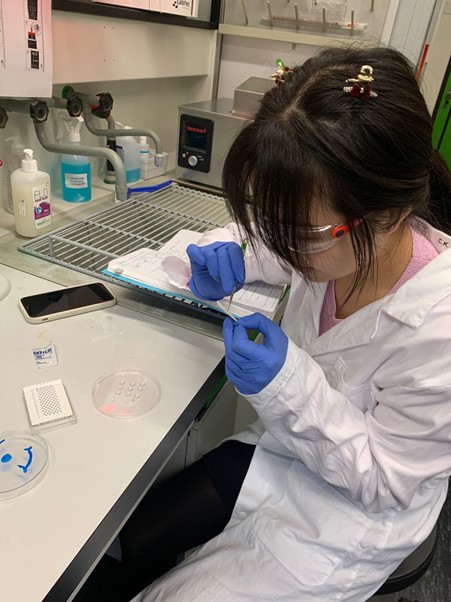
Yifan Cui is a third-year doctoral student in Prof. Mark Tibbitt’s Macromolecular Engineering Laboratory at D-MAVT and a fellow of the ETH ALIVE Advanced Engineering with Living Materials initiative. She is also MaP student representative 2024/25.
My research
I embed bacteria within a 3D printed hydrogel network to create a new, “living” material, which sequesters and stores CO₂ from the air. The bacteria I use are among the first photosynthetic organisms on Earth, dating back roughly 3 billion years. All they need to thrive is sunlight and (sea) water. People often associate bacteria with disease, which is why I call mine by their full scientific name. Cyanobacteria— after their distinct cyan-blue colour—has a nice ring to it. I find these bacteria fascinating and very cute. They are so fat!
Though my research is still in its early stages, it has real-world potential. Professor Mark Tibbitt is optimistic that our work could one day have a real impact. Such living materials could for example be applied to rooftops or as a coating on various surfaces. A major challenge we face is the high cost of hydrogels, but I’m working on a potential solution by introducing a second bacterial species that can produce its own hydrogel (i.e. an extracellular matrix—essentially a jelly-like, sticky substance). I obtained this strain from Karen Antorveza, a contact I made through the ALIVE network.
My MaP moment
Being part of ALIVE, which was initiated by MaP, has allowed me to connect from the start with researchers from other disciplines. Collaboration leads to rewarding results. Therefore, I volunteered for the 2023 MaP Graduate Symposium, helping to design marketing materials and judging in the poster competition. This year, as the MaP student representative, I advised MaP on their onboarding event to make it more appealing to new students. After some discussion, we decided on customised lab books as giveaways. The event, held on 12 November, attracted a great deal of interest!
My future
One of my dreams is to open a bakery with a friend—not as a primary career, but as a passion project. In the meantime, my main goal is to stay in academia and continue researching happily. As a first step, I’ll hopefully become Dr Cui and then find a postdoctoral position somewhere. I don’t really envision myself entering industry or becoming an entrepreneur for now, but never say never!
About ALIVE: https://map.ethz.ch/research/alive.html
(This article was published on 19 December 2024 on LinkedIn)
“Communicating science is as important as the research itself”
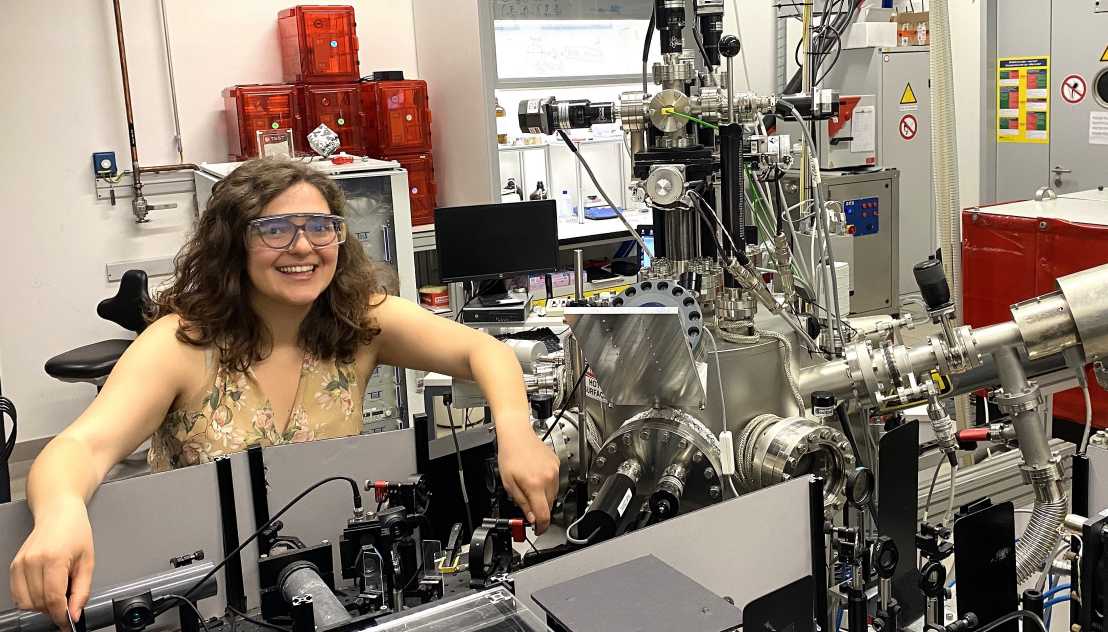
Ipek Efe is a fourth-year doctoral student in Prof. Morgan Trassin’s team at the Laboratory for Multifunctional Ferroic Materials. She is a former president of SAM – Scientific Staff Association at the Department of Materials.
My research
I focus on ferroelectric materials. Due to their crystal structure, they naturally separate and store positive and negative charges on their opposite ends. These materials complement and may even replace semiconductors in future electronic devices as they are more energy-efficient and can provide higher information storage density. Now, however, their potential is still limited by issues like decreasing stability (so-called “fatigue”) after repeated use or lack of control of their properties.
Currently, I’m working on a thin film material that combines different ferroelectric compounds in one structure—think of it as a composite material but with constituents as thin as several atomic layers. The resulting new material shows new macroscopic properties while still preserving the functionalities of the parent compounds. Thanks to these new properties, we are now one step closer to the development of fatigue-free ferroelectric devices. Our paper on this project is under review and will hopefully be published soon.
My MaP moment
A defining moment for me at MaP was giving a talk at the 2023 MaP Graduate Symposium. I had spoken at conferences before, but this talk was different—there was a larger, more diverse audience, and I had only 10 minutes to present my work to an audience outside my field. It was a challenge, but it taught me how to simplify complex ideas for a broader audience.
After my talk, I was approached by several fellow students, and I realised that my research had more in common with work in other departments than I had thought. This experience reinforced my belief that communicating science is as important as doing the research itself. It’s crucial to make scientific advancements accessible to the public so that, when innovations reach society, they’re understood and accepted.
My future
I’m passionate about materials science because it bridges engineering and natural sciences across different scales—from nano to macro. I love the intellectual challenge of academia and the sense of discovery that comes with it. I also like teaching, as I see it as a way to inspire and mentor the next generation of scientists. My goal is to continue in academia. I’m particularly interested in doing a postdoc in the US after completing my doctorate at ETH Zurich, where I’ve also earned my Master’s. In the midterm, I see myself working in Europe or my native Turkey though.
(This article was published on 28 November 2024 on LinkedIn)
“We work with dirt, not with advanced materials.”
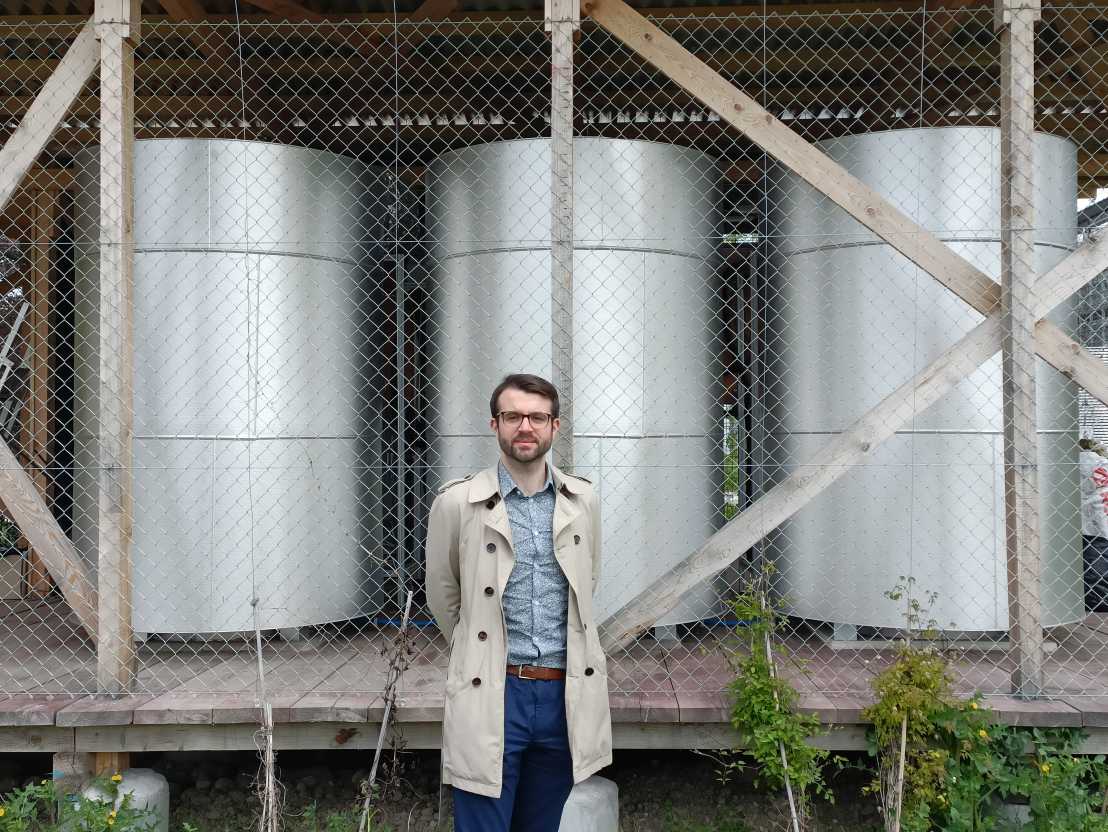
Samuel Heiniger is a second-year doctoral student in Prof. Wendelin Stark’s Functional Materials Laboratory at D-CHAB. He works on a solution to chemically store solar energy for the winter months when electricity is scarce.
My research
Together with my group, I investigate novel processes for decentralized seasonal energy storage, particularly the steam iron process. It enables to safely handle hydrogen in the form of iron powder. The goal is to shift local surplus electricity from summer to deficit hours in winter to provide a year-round supply of renewable electricity at a low cost.
I established a test facility in front of the HCP building at ETH Hönggerberg, designed to supply energy to about four households. The facility features tanks containing iron ore, an inexpensive, sustainable and safe material. By introducing (non-pressurized) hydrogen into the tanks, we produce iron powder, providing a secure means of hydrogen storage. When needed, the stored hydrogen can be reclaimed by introducing steam.
The primary challenges of the project were not technological but practical issues, such as preventing pipes from freezing during winter. Our next step is to scale up the facility to serve approximately a hundred households. As we will need millions of tons of iron ore (aka dirt) for this, we must be pragmatic and focus on techno-economic feasibility, available materials, and real-time performance.
My MaP moment
The first year of my doctorate was hard. I had to cope with the fact that I had to work on my own. By now, I’m used to it and wouldn’t want it any other way. My goal is not perfection, but to find solutions that work. Failing is part of this process. We work with dirt, not with advanced materials. Even though I signed up for MaP Doctoral School, I haven’t taken part in any events yet. Now that I know that MaP is not just about new materials, maybe I’ll try out one of their workshops in ethics or science communication.
My future
I would like to continue working in the field of energy storage. Isn’t it the point of a doctorate to continue using the knowledge you gained? To me, it’s a privilege to have a project that works and that is relevant to society. Now that the proof of concept on a small scale is here, I want to put it into practice in real life. My goal is to solve real-world problems. I guess this means that the academic track is not necessarily for me. I very much like entrepreneurship and doing real things.
(This article was published on 7 May 2024 on LinkedIn)
“I want to understand the various languages of mycelium”
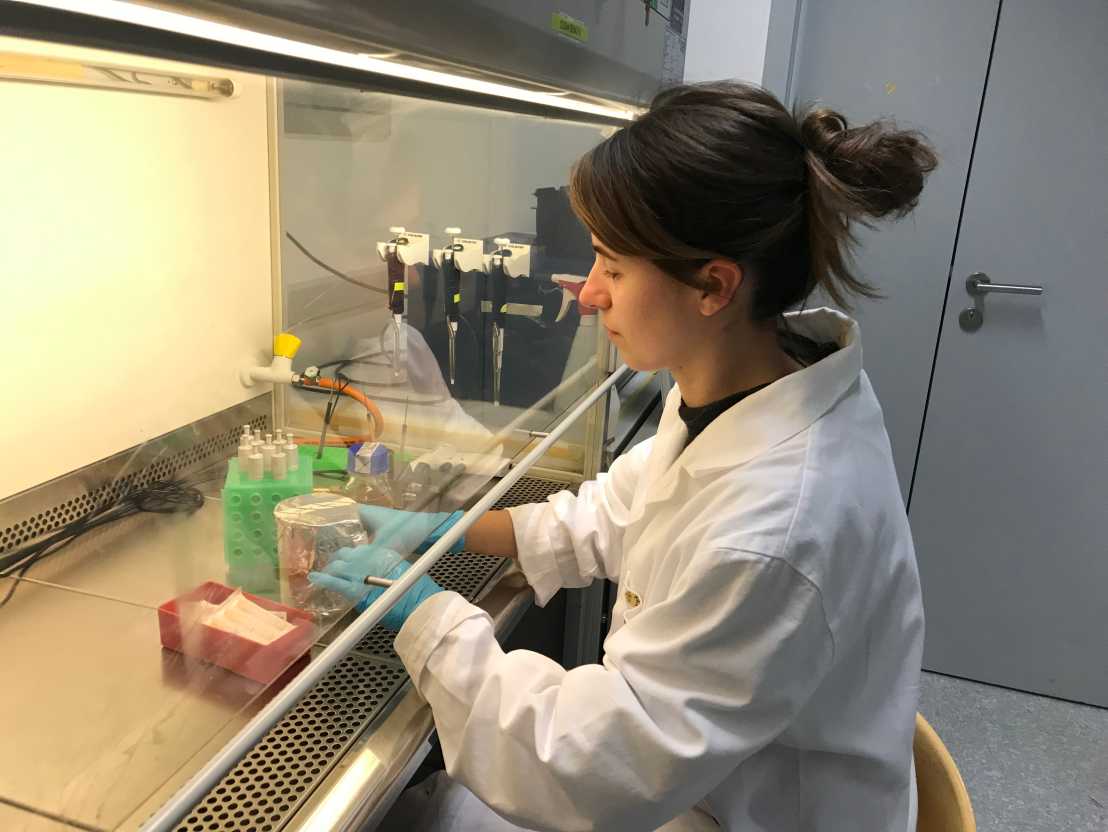
Judith Gómez Cuyàs is a first-year doctoral student in Prof. Ralph Spolenak’s ETH Laboratory for Nanometallurgy at D-MATL. She is an ETH ALIVE fellow and part of the ALIVE CLiMa work stream.
My research
My research focuses on mycelium, the root-like structure of a fungus. I’m interested in its mechanical and optical properties at the microscale. While my approach predominantly stems from materials science, it’s also very multidisciplinary. This is why, right from the beginning, my group leader Prof. Ralph Spolenak, senior scientist Dr. Henning Galinski and I reached out to Prof. Markus Künzler from the Institute of Microbiology for insights into the biological aspects of mycelium. Markus Künzler not only was very helpful, but he also connected me to my research partner and fellow doctoral student Blanka Sokolowska. Together with her, I designed a simple setup for growing mycelium into glass capillaries. Ultimately, we want to stimulate a single mycelium filament and understand its response mechanism. At the current stage though, we are still trying to better understand mycelium and searching for the best way to grow single filaments.
My MaP moment
My wish to deepen my knowledge about the living organism mycelium led me to ALIVE (Advanced Engineering with Living Materials), a MaP project, and MaP chair Professor Spolenak’s Nanometallurgy group. All the people I’ve met at ETH Zurich have been incredibly helpful, showing me how to use lab equipment and guiding me through the process. While during my first few weeks in Zurich last summer I had felt a bit disoriented, I now move with ease in and between the labs at D-MATL, D-BIOL, and D-ARCH (where the ALIVE mycelium lab is located).
My future
I enjoy researching. For now, this is at ETH Zürich. Where I will go and what I will have accomplished in four years – it’s all still very far away. I hope to keep working with mycelium because it has so much potential. Leather made from fungi is just the start of it. Who knows what other applications will be possible if we manage to understand the various languages of mycelium!
(This article was published on 25 March 2024 on LinkedIn)
“ALIVE is very interdisciplinary and participatory”
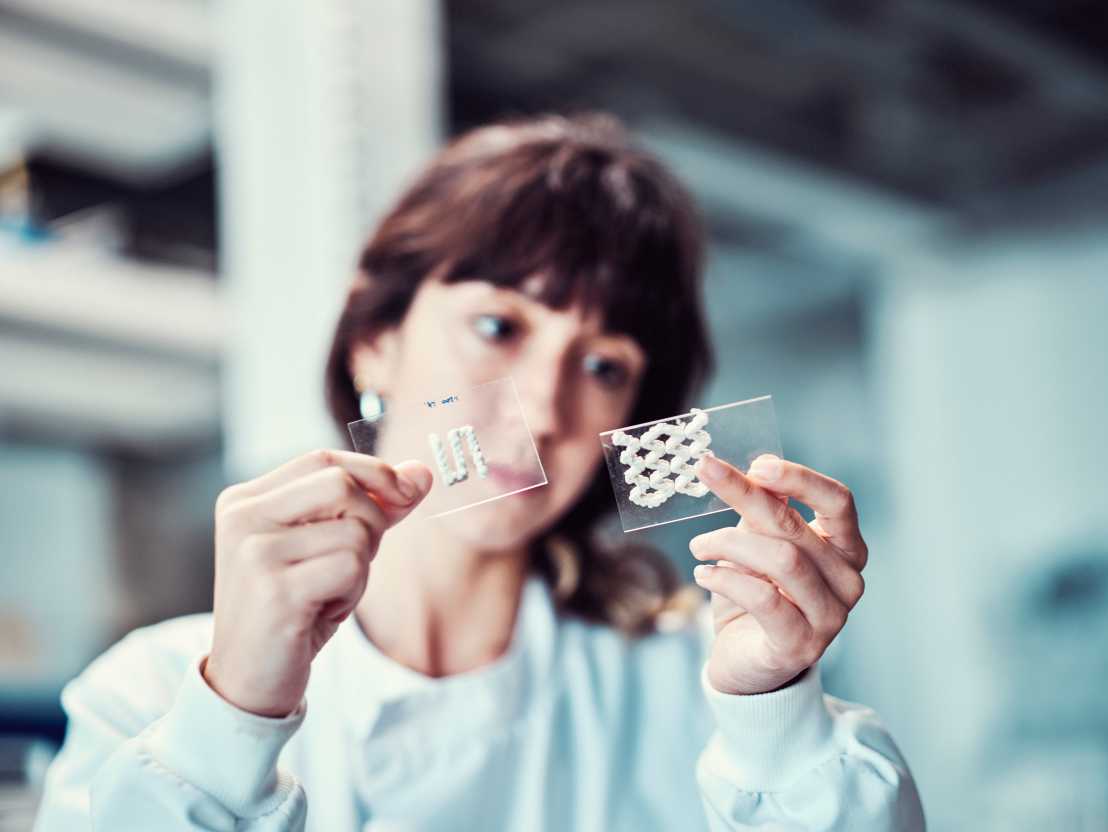
Karen Antorveza Paez is a second-year doctoral student in Prof. Benjamin Dillenburger's Digital Building Technologies (DBT) group at D-ARCH. She is an ETH ALIVE fellow and part of the ALIVE CLiMa work stream.
My research
I’m working on incorporating living organisms into the built environment, using a technology called Microbially Induced Calcium Carbonate Precipitation (MICP). The resulting product is an alternative to concrete. I am investigating various design and additive manufacturing methods, also known as 3D printing, to enhance the bio-cementation process specifically for architectural applications. What makes our approach unique is that we harness bacteria to produce natural cement at room temperature. Traditional cement production requires temperatures of 1400°C. If the production works at room temperature, significant amounts of fuel can be saved, and CO2 emissions avoided. We are also investigating the use of waste by-products as raw materials, which makes the process even more sustainable.
My MaP moment
I am a MaP ALIVE doctoral fellow (ALIVE: Advanced Engineering with Living Materials). The Living Systems for Carbon Capturing in Self-Aware Infrastructure (CLiMa) group is my ETH tribe. We are about 30 people – including eight professors from various departments– and hold meetings every six months to update each other on our work. I enjoy the interdisciplinary and participatory nature of ALIVE. The direct exchange with people from fields such as materials science and microbiology is invaluable and greatly enhances my research as an architect. We even discuss the project budget and what we need to purchase for our labs. As a doctoral student, it’s not common to be involved in this kind of decision-making, so it’s a special experience.
My future
I’m in my second year of my doctorate and still exploring multiple directions in my research. Although I came for the research, I’ve discovered that I also very much enjoy teaching. For my future, I am very open to what will come. I enjoy the research environment, so I could imagine myself continuing my academic career, but more with a focus on applied research. Ultimately, what I do is more important than the setting though, hence I can also imagine myself working in the R&D department of a company.
(This article was published on 5 February 2024 on LinkedIn)
“Sustainability is at the core of our research”
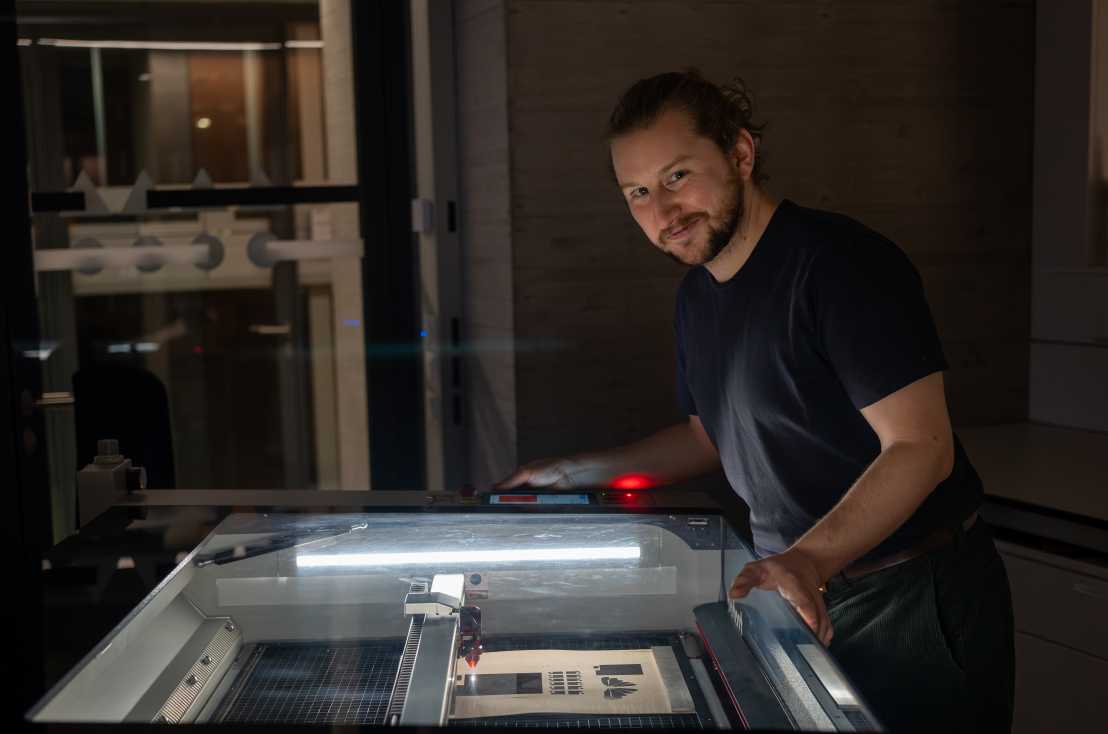
Christopher H. Dreimol is a fourth-year doctoral student in Prof. Ingo Burgert’s Wood Materials Science group at D-BAUG. In his role as MaP Student Representative, he initiated the MaP Minds & Munchies event series.
My research
I make wood electrically conductive. To do this, I coat the wood with an aqueous bio-based coating inspired by a historic iron-gall ink, which was already used by Leonardo Da Vinci for his drawings and manuscripts. The ink-coated wood is then graphitized with a commercial CO2 laser to make the wood electrically conductive. The small amounts of iron ions used in the ink help us to catalyze the laser-induced graphitization process, making it more efficient. This is why we call the process Iron-Catalyzed Laser-Induced Graphitization (IC-LIG). It is a very simple process that we are now trying to scale up. However, it took a lot of perseverance and creativity to develop such an approach, because from the beginning we have restricted ourselves to sustainable processes and materials.
So far we have worked with wood and paper, but we are now also experimenting with (sustainable) synthetic materials. The conductive materials we produce can later be used for sensors (e.g. for measuring strain, temperature, or humidity), interactive surfaces such as touch buttons, and to build energy harvesting and storage devices. Our research is very application-oriented, but this requires a fundamental understanding of the basic principles from a process and material development perspective.
My MaP moment
As MaP student representative, I initiated an event format in collaboration with the MaP Executive Office: MaP Minds & Munchies. The idea behind Minds & Munchies is to bring graduate students together in an informal setting over lunch while two graduate students present their research, difficulties, ideas, or a personal scientific perspective. We aim to create an atmosphere where everyone feels safe and confident to ask questions and share their opinions. We had a successful start in the fall, but I hope that more students will join us for the next sessions. This kind of exchange strengthens our interdisciplinary research and personal connections - and most importantly, it's about having fun and a good time together!
My future
In a few months, I will finish my doctoral studies. However, my focus is already on a new project that has been approved by the SNSF. As a postdoctoral fellow, I will be working on extending the use of the CO2 laser to allow for other functionalization treatments of the wood surface. What comes after that is written in the stars.
I am a trained industrial mechanic (Polymechaniker), which is very useful as I now speak both "languages" the scientific and the industrial. Therefore, I can imagine working at the interface between science and industry, maybe even starting my own company. I'm also open to the academic career path, but getting a faculty position/professorship requires a lot of luck. We shall see!
More on Christopher’s research: external page https://www.nature.com/articles/s41467-022-31283-7
MaP Minds & Munchies: https://doctoral-school.ethz.ch/events/map-minds-munchies
(This article was published on 15 January 2024 on LinkedIn)
2023
"Giving a talk at the symposium boosted my confidence"
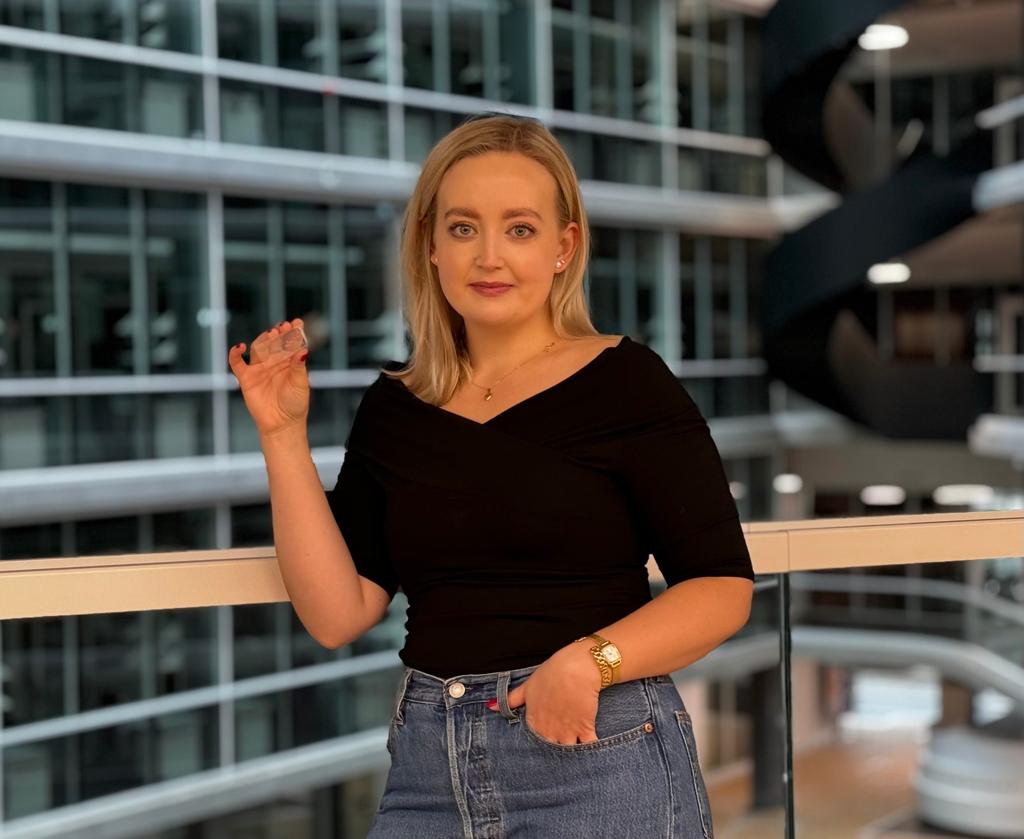
Sara Svanberg (Bioanalytics, D-BSSE, ETHZ in Basel) studies in the ‘Science and Technology of the Small’ track of MaP Doctoral School. She was part of the Graduate Symposium 2023 Organising Committee.
My research
The Bioanalytics group under Prof. Petra Dittrich is very interdisciplinary. I’m working with organ-on-a-chip (OOC) technology, where I combine microsystems engineering and biology. I focus on gingiva, a tissue in the mouth that is often inflamed, which is caused by bacterial infections. I’m trying to understand how healthy tissue compares to diseased tissue and how we can reverse the effects of the infection. The benefits of OOC lie in the fact that we directly work with human cells and on a very small scale. This is not only more ethical, but also more efficient than working with cells from mice or directly with animals, for example. Not only the pharma, but also the beauty industry is very interested in applying this research.
My MaP moment
The 2022 MaP Graduate Symposium at ETH Hönggerberg was my first conference at ETH. I was invited to give a talk – a very good experience that helped me a lot for other conferences. The exchange with the community during the symposium boosted my confidence and made me more successful in my interactions with other scientists. Because I felt thankful for the opportunity, I wanted to give back to the MaP community. That’s why I decided to volunteer for the organising committee of the MaP Graduate Symposium a year later.
My future
Very soon, my group will move into the new facilities right next to Biozentrum (The Center for Molecular Life Sciences) and the university hospital. We are all excited about it! I have about one-and-a-half to two years left of my doctoral studies. Afterwards, I want to continue my research. There is so much more to do in Life Sciences. Whether that will be in academia or in an industry setting is still an open question. Basel is my hometown now. I’d like to take advantage of the opportunities the place has to offer.
(This article was published on 14 November 2023 on LinkedIn)
"The MaP Graduate Symposium? I loved it!"
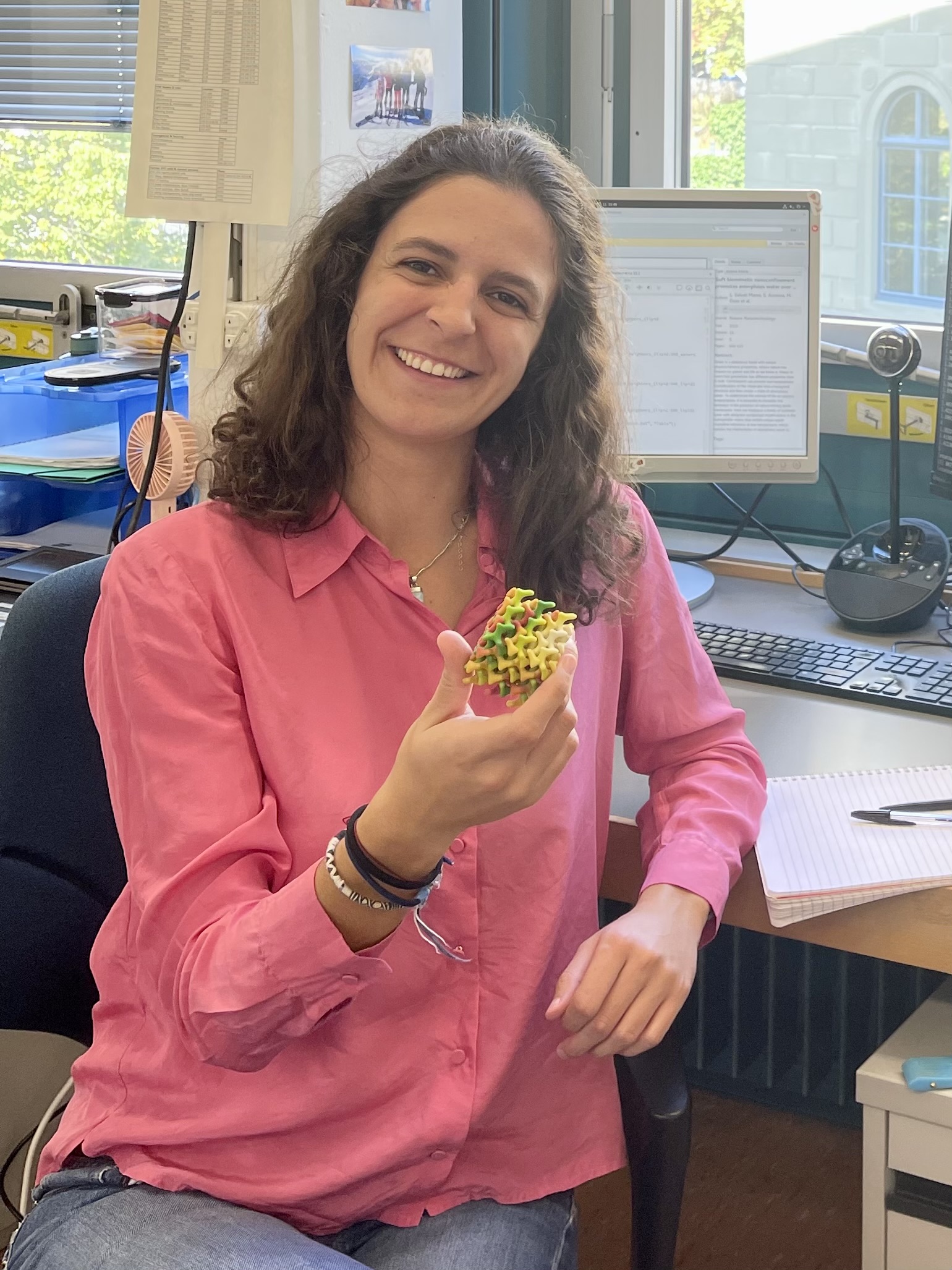
Eva Zunzunegui-Bru is a doctoral student in Prof. Dr. Raffaele Mezzenga's group (Food and Soft Materials, D-HEST) studies in the Soft Materials track of MaP Doctoral School. She was part of the Graduate Symposium 2022 Organising Committee.
My research
Continuously asking questions about the world that surrounds us is what guides me as a physicist. In my doctorate, I study the properties of nano-confined water inside lipid mesophases. With molecular dynamics simulations, we are able to determine the atomistic description of these lipid-water-systems for the first time. The fundamental study of these systems can help in understanding their applications in biomedical, pharmaceutical and materials sciences. I think it is very special to have the opportunity to be in a group together with experimentalists. Thus, I am able to see my work not only numerically but also in the real world. I am passionate about science and am excited to further develop my expertise through this doctorate.
My MaP moment
Signing up for the organising committee for the MaP Graduate Symposium 2022 during my first year at ETH was the best decision I could have made. I got to know other doctoral students from different departments, brainstormed ideas with them, and saw the work behind a symposium with about 200 participants. The day of the symposium itself was an absolute highlight. To experience the interdisciplinary, collaborative atmosphere and to see new research, to talk to people – it was so special. I loved it because I felt part of it!
My future
After a Master’s in Spain and doctoral studies here at ETH I’ll probably do a postdoc outside of Europe. I am eager to explore other working environments and to learn as much as I can from them. My dream would be to become a professor one day. Along the way I hope to continue with my professional and personal growth in the collaborative and interdisciplinary environment that science in my field offers.
Website MaP Graduate Symposium: https://doctoral-school.ethz.ch/events/grad-symp
(This article was published on 23 October 2023 on LinkedIn)
“I am excited to see where the journey of discovery will lead me.”
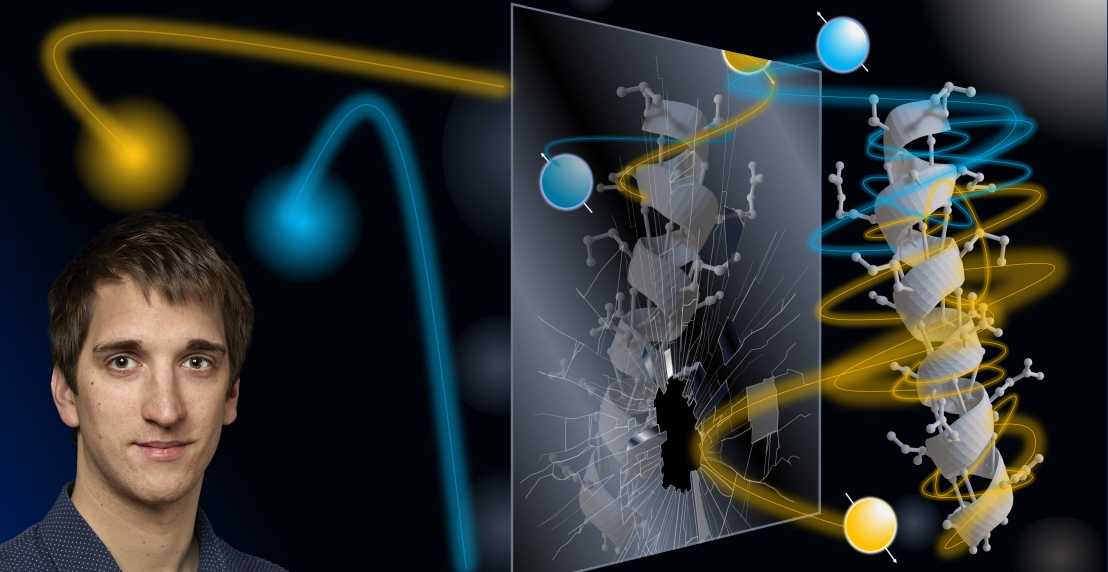
Pius M. Theiler is a doctoral student at Department of Mechanical and Process Engineering (D-MAVT), ETH Zurich, Nanotechnology Group. He is affiliated with the 'Science and Technology of the Small' track of MaP Doctoral School.
My research
My research revolves around the chirality-induced spin selective (CISS) effect. This quantum mechanical effect can be seen in electrons in molecules or in crystals without mirror symmetries (=chiral). The CISS effect may play a central role in the origin of life, in chemistry, and in spintronic applications.
The CISS effect manifests itself in an inexplicably large shift of the charge distribution in the chiral molecule, which differs in each case from the one its mirror-image version displays. My team and I have developed a new measurement method that can detect these charge differences. The results of our measurements allow us to conclude that the mirror symmetries are broken in space or time and thus to rule out long-standing attempts at explanation of the CISS effect. Scientists will need to build theories on different foundations than where they have done research before. I am excited to see where the journey of discovery will lead me.
My MaP moment
Thanks to MaP Doctoral School I got in contact with people from other groups at ETH. Some of them worked in a similar research field but in a different domain, which meant they had approaches and terminologies different from mine. Communicating my research and seeing how they reacted to it opened entirely fresh perspectives on problems I faced. The Storytelling Workshop helped me a lot. I learned that it's not only what I say that matters, but also how and why I say it. To make sure others understand, my presentation needs to be neat and catchy and, most importantly, adapted to their (scientific) background.
My future
I dream of an academic career. I like to get to the bottom of things to find out what keeps this world together. Plus, I love to teach. As a group leader, I would advocate a collaborative environment. Making sure everyone feels mentally safe and valued as an individual is very important to me. Also, it’s a precondition to achieving a team’s full potential. But first things first: I expect to defend my thesis this December.
(This article was published on 25 September 2023 on LinkedIn)